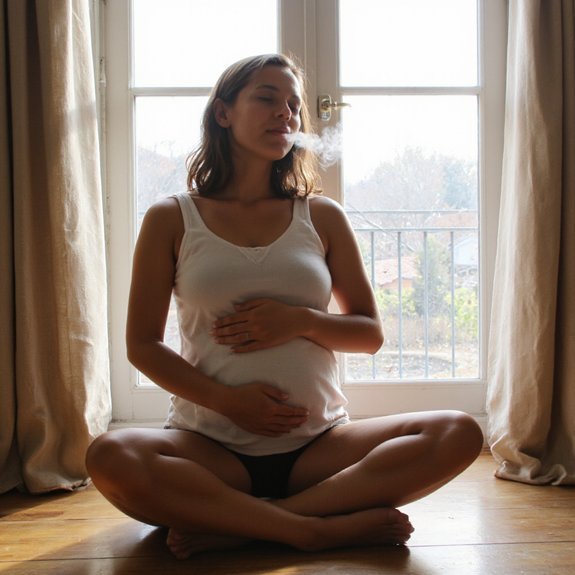You can reduce stress and anxiety with practical, evidence-based steps that change how your body and mind respond. Start with breath control, grounding, sleep, movement, and simple cognitive shifts that research supports. I’ll outline clear, manageable strategies you can try and how to build them into your day, so relief becomes more consistent—you’ll want to know which to try first.
Key Takeaways
- Practice regular breathing and grounding exercises to calm your nervous system and reduce immediate anxiety.
- Do consistent aerobic exercise and short movement breaks to lower cortisol and improve mood and sleep.
- Prioritize sleep hygiene: consistent sleep times, cool dark bedroom, limit caffeine and screens before bed.
- Use cognitive techniques—track automatic thoughts, challenge distortions, and practice reappraisal to reduce persistent worry.
- Seek professional support early for persistent symptoms, medication discussion, or crisis intervention if safety is a concern.
Understanding What Happens in Your Body During Stress

When you face a perceived threat, your brain quickly activates the sympathetic nervous system and the hypothalamic–pituitary–adrenal (HPA) axis, releasing adrenaline and cortisol that raise your heart rate, speed your breathing, sharpen alertness, and increase muscle tension. You’ll experience a rapid stress response that’s adaptive short-term but costly if sustained. Neurotransmitter activity shifts — noradrenaline and dopamine rise to prioritize focus while serotonin regulation can change, altering mood. The hormonal impact of prolonged cortisol exposure affects metabolism, immune function and sleep cycles, and research links chronic activation to cardiovascular risk. Clinically, you’ll notice physical symptoms like gastrointestinal upset, headaches, tremor, or persistent tension. That evidence should motivate innovation in monitoring and targeted interventions rather than alarm; you’re not failing, you’re responding. Aim for precise assessment, measurable metrics, and tailored strategies that restore regulatory balance and reduce allostatic load. You’ll benefit from data-driven tools that track and inform progress consistently.
Simple Breathing Exercises to Calm Your Nervous System

You can use simple breathing exercises to engage the vagus nerve and lower heart rate—two clinically supported methods are diaphragmatic breathing and box breathing. Diaphragmatic breathing teaches you to breathe deeply into the belly to improve oxygenation and reduce sympathetic arousal. Box breathing (inhale-hold-exhale-hold in equal counts) gives you a structured rhythm that helps reset your nervous system when you’re experiencing acute stress.
Diaphragmatic Breathing
How does diaphragmatic breathing calm your nervous system? You engage the diaphragm to lower heart rate, reduce sympathetic arousal, and increase vagal tone—effects supported by randomized and physiological studies. Practice by inhaling slowly through your nose for a comfortable count, letting your abdomen expand, then exhale fully; this simple act exemplifies diaphragmatic benefits and modern breathing techniques. Do this for five minutes when you’re tense; you’ll likely notice calmer attention and reduced muscle tension. Start seated with a straight spine and relaxed shoulders; monitor progress with pulse or perceived stress ratings. If you have respiratory or cardiac conditions, consult a clinician before intensive practice. These evidence-based, user-focused steps help you reclaim regulatory control in daily life and during acute stress. Apply them with curiosity.
Box Breathing
Box breathing offers a simple, structured way to build on diaphragmatic breathing by pacing inhalation, breath-hold, exhalation, and pause in equal counts (commonly 4-4-4-4). You’ll inhale slowly for four seconds, hold for four, exhale four, then pause four, repeating for several minutes. Research shows this pattern engages the parasympathetic system, lowers heart rate variability, and reduces perceived stress when practiced regularly. Start seated, shoulders relaxed, eyes open or closed, and adjust counts to your tolerance. You’ll notice calmer focus, improved tolerance for uncertainty, and clearer cognitive control. Explore variations and app-guided protocols to innovate practice safely. Clinically, box breathing benefits are measurable; pair them with diaphragmatic technique and brief behavioral strategies for stronger, scalable stress reduction. Try short sessions daily to build reliable resilience.
Grounding Techniques to Stop Panic Quickly

Several grounding techniques can interrupt panic within minutes by shifting your attention from overwhelming internal sensations to concrete sensory input. When you use mindfulness techniques and sensory grounding, you engage brain circuits that reduce threat responses; research shows brief focused attention lowers physiological arousal. Try quick, practical steps you can do anywhere to regain control and slow a panic cascade:
- Name five things you see, four you can touch, three you hear, two you smell, one you taste.
- Hold an object, notice texture, temperature, weight for 60 seconds.
- Use paced tapping: tap each fingertip to thumb while counting breaths.
- Describe your environment aloud with neutral, specific details for 30 seconds.
Practice these clinically informed exercises during low-stress moments so they’ll be automatic under pressure. They won’t erase distress instantly, but they’ll reliably reduce heart rate and intrusive thoughts, helping you return to deliberate, innovative coping strategies starting now.
How Sleep and Rest Affect Anxiety Levels
Because sleep consolidates emotional memories and restores prefrontal control over the amygdala, inadequate or fragmented sleep makes you more reactive to stress and increases anxious symptoms. When you face sleep deprivation, stress hormones rise and your threat-detection system stays primed. Improving sleep quality reduces sympathetic activation and improves daytime regulation. Start by stabilizing your circadian rhythm: consistent light exposure, fixed sleep-wake times, and technology curfews help recalibrate timing systems. Adopt sleep hygiene and restorative practices—cool, dark environment, caffeine cutoffs, and brief relaxation techniques before bed—to lower physiological arousal. Design personalized bedtime rituals that signal safety and predictability; try paced breathing, progressive muscle relaxation, or guided imagery. Track outcomes objectively with sleep logs or wearables, iterate interventions, and consult clinicians when insomnia persists. These evidence-based, innovative steps optimize restorative sleep, reduce stress-hormone burden, and enhance emotional resilience and cognitive flexibility so you can approach anxious moments with clearer control.
The Role of Physical Activity in Managing Stress
You can reduce stress with regular aerobic exercise, which lowers cortisol, raises endorphins, and improves sleep and mood. Even short bouts of movement—walking, brisk cycling, stretching, or gentle yoga—activate the parasympathetic system and promote relaxation. Start with what feels doable and monitor the effects so you build a sustainable, evidence-based routine that eases anxiety.
Aerobic Exercise Benefits
When you’re feeling overwhelmed, regular aerobic exercise—brisk walking, cycling, or swimming—reduces physiological arousal and improves mood by lowering cortisol while raising endorphins and brain-derived neurotrophic factor (BDNF). You can use interval training to increase endorphin release, sharpen cardiorespiratory fitness, and accelerate progress toward measurable fitness goals. Consider structured routines that prioritize routine consistency and social interaction to reinforce adherence.
- mood enhancement through sustained activity
- interval training for efficient heart health gains
- group sessions to enhance social interaction
- tracking fitness goals for long term benefits
Over months, these strategies improve cardiovascular markers, strengthen stress resilience, and support cognitive function. Start at your level, track outcomes, and consult a clinician if you have medical concerns. Evidence shows consistent aerobic plans reduce anxiety and enhance overall wellbeing.
Movement for Relaxation
While gentle, intentional movement might seem simple, it reliably shifts the nervous system from hyperarousal toward calm by reducing sympathetic activity, boosting parasympathetic tone, and engaging interoception—mechanisms supported by randomized trials of yoga, tai chi, and mindful walking. You can use brief protocols: 10–20 minutes of slow yoga stretches to downregulate breathing, progressive muscle relaxation, or mindful walking to interrupt rumination. If you prefer creative approaches, guided dance therapy or improvised movement offers embodied processing, social connection, and endorphin release. Aim for consistency over intensity; dose-response studies link regular low-to-moderate activity with sustained anxiety reduction. Monitor symptoms, start small, and adapt practices to your capacity. Collaborate with clinicians when symptoms are severe or impairing to integrate movement into a thorough care plan and recovery.
Nutrition, Caffeine, and Alcohol: What to Watch For
How do what you eat and drink influence your stress and anxiety levels? You can reduce physiological arousal by attending to nutrition timing, hydration importance, and mindful choices. Regular meals and healthy snacks stabilize blood sugar and mood; delaying meals often increases irritability and anxiety. Limit caffeine late in the day and explore caffeine alternatives like herbal tea or decaf to prevent sleep disruption. Practice alcohol moderation — alcohol can worsen anxiety and disturb sleep even when it feels calming.
- Eat balanced meals on a schedule to steady energy.
- Choose healthy snacks with protein and fiber for resilience.
- Swap high-caffeine drinks for caffeine alternatives in the afternoon.
- Treat alcohol as a depressant; set clear moderation goals.
These steps reflect clinical evidence linking diet, stimulants, and alcohol with stress physiology. You’ll likely see measurable reductions in jitteriness and sleep disturbance when you adapt these habits. Keep monitoring your progress.
Reframing Negative Thoughts and Worry Patterns
Your thoughts shape how your body responds to stress, so changing unhelpful thinking can lower anxiety and physical arousal. Start by identifying automatic negative thoughts—what you tell yourself in moments of worry—and test them against evidence. Use cognitive restructuring to label cognitive distortions (catastrophizing, mind-reading) and generate balanced alternative appraisals. Thought journaling can speed this process: record the trigger, the automatic thought, the emotion intensity, evidence for and against, and a revised thought. Practice repeatedly; randomized trials show structured reappraisal reduces physiological and subjective anxiety. Be compassionate with yourself—error-prone thinking is learned, not fixed—and set measurable, incremental goals for practice. If intrusive worries persist or impair function, consult a clinician trained in CBT for tailored strategies and exposure where appropriate. Innovate within evidence-based methods: pair digital thought-tracking tools with brief in-session modeling to accelerate skill acquisition and maintain fidelity to the technique. You’ll see measurable shifts with practice.
Building a Daily Routine That Reduces Anxiety
You can reduce daily anxiety by structuring predictable morning grounding rituals—brief breathwork, light movement, and intent-setting—that lower physiological arousal and improve focus. In the evening, a consistent wind-down routine—screen curfew, low-stimulus activities, and calming breathing—helps shift your nervous system toward rest. Small, evidence-based adjustments to both routines produce measurable reductions in baseline anxiety and improve sleep over time.
Morning Grounding Rituals
When morning begins, brief grounding rituals—focused breathing, a two-minute body scan, or intentional sensory noticing—can lower physiological arousal and set a calmer tone for the day. You can design a concise sequence that fits innovation-focused schedules and supports resilience. Start with mindful meditation for two to five minutes, followed by morning gratitude naming three specific things, then gentle movement to reconnect body and breath. Use cues, timers, and progressive adjustment based on measurable response. Keep it brief, reproducible, and evidence-aligned.
- 2–5 minutes mindful meditation
- Name three morning gratitude items
- Two-minute body scan
- Intentional sensory noticing (sound, touch, breath)
Track mood and heart-rate variability to iterate and optimize your ritual regularly. These practices reduce sympathetic activation, improve attention, and enhance emotional regulation when practiced consistently.
Evening Wind-Down Routine
As evening approaches, establish a brief, consistent wind-down routine you can follow nightly to lower physiological arousal and prepare for restorative sleep. Choose 30 to 45 minutes of predictable activities: dim lights, put devices away, and do two evidence-based practices. First, practice Evening Meditation — a guided 10 to 15 minute breath-focused session to downregulate sympathetic activity and improve sleep latency. Second, engage in Mindful Journaling for 5 to 10 minutes: note one achievement, one worry, and a concrete next step to offload cognitive load. Add progressive muscle relaxation or light stretching if you prefer somatic work. Track effects for two weeks, adjust timing, and prioritize consistency over intensity. If insomnia or severe anxiety persists, consult a clinician for tailored interventions. You’ll iterate creatively to find what reliably calms you each night.
When and How to Seek Professional Help
How do you know it’s time to seek professional help for stress or anxiety? You should consider mental health services when symptoms impair daily functioning, coping strategies fail, or risk increases; professional assessments can clarify diagnosis and guide next steps. Evidence supports timely referral to reduce chronicity.
- Consider Therapy options when persistent symptoms resist Self help resources.
- Ask about Medication management if physiological symptoms or severe distress persist.
- Join Support groups to reduce isolation and learn adaptive Coping strategies.
- Seek Crisis intervention immediately for safety concerns or suicidal thoughts.
You’ll get collaborative, evidence-based care that may combine assessments, therapy, medication, and community resources. Clinicians use validated measures and offer innovative modalities (telehealth, digital CBT) to fit tech-forward preferences. If you’re uncertain, a brief consultation with mental health services can quickly orient you to appropriate levels of care. Act promptly — early intervention improves outcomes and preserves functioning and resilience.
Creating a Personal Stress-Reduction Plan
Because stress responses vary, you’ll build a focused plan that targets your triggers, symptoms, and evidence-based coping skills. Start by listing stress triggers and symptoms, set personalized goals, and choose coping strategies—mindfulness practices, self care techniques, time management, and distraction methods. Note environmental factors and activate support systems. Track progress; journaling benefits include clarity and pattern detection. Use brief, innovation-friendly experiments to test interventions and iterate.
| Area | Action |
|---|---|
| Triggers | Identify, rate, reduce exposure |
| Skills | Mindfulness, breathing, distraction |
| Routine | Time management, self care techniques |
| Support | Peer, professional, community |
Review weekly, measure outcomes, and adjust personalized goals based on data. You’ll maintain clinical rigor while staying empathetic and creative. Integrate brief sensor-based metrics, scheduled check-ins, and adaptable routines; prioritize scalable, evidence-informed techniques while preserving reward structures that reinforce adherence and allow rapid refinement of your plan in response to changing environmental factors and measured stress reductions over time with data.
